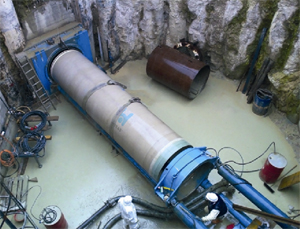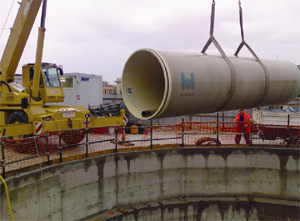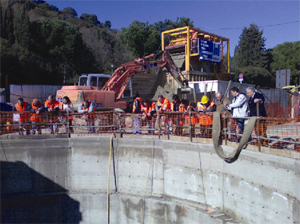One of World’s Earliest Sewers in Rome Upgraded Using Microtunneling
 Roman engineers built the Cloaca Maxima, the city’s main drain system late in the sixth century BC. Water from the baths, latrines as well as runoff was collected via the wastewater system and discharged directly into the Tiber River.
Roman engineers built the Cloaca Maxima, the city’s main drain system late in the sixth century BC. Water from the baths, latrines as well as runoff was collected via the wastewater system and discharged directly into the Tiber River.
The collection of multiple effluents made it necessary to have large openings in the streets, which undoubtedly caused odor and sanitation problems. The system was later enclosed in the third century BC. Part of the current sewer network is still made up of these ancient underground structures.
More than 25 centuries later, Roman engineers are continuing to improve the sewer systems. Only now, concerns of health, safety and tourist disruption are of top propriety.
The municipality of Rome designed a 54-in. diameter sewer bypass in one of Rome’s central quarters, Farnesina. The new line, 1,000 ft in length, connects two existing 138-in. diameter concrete sewer collectors.
Farnesina, an area steeped in history, is situated on the right bank of the Tiber River. The area is headquarters of the Italian Foreign Ministry, home to the ancient Milvio Bridge (109 a.c.), and two meaningful sports facilities (the Olympic stadium and the Foro Italico). Two major roadways converge in the area, namely the junction of the Cassia and the Flaminia. In order to minimally affect this busy and densely populated area by the sewer upgrades, a trenchless solution was sought.
 Care was taken during the construction to minimize distribution so that the tourist area would be able to keep up its busy flow, especially during sports events when thousands of visitors gather in the area. The microtunneling alternative, apart from being non-disruptive, also kept the construction site comparably small.
Care was taken during the construction to minimize distribution so that the tourist area would be able to keep up its busy flow, especially during sports events when thousands of visitors gather in the area. The microtunneling alternative, apart from being non-disruptive, also kept the construction site comparably small.
SAFAB Spa., a renowned Italian contractor specializing in hydraulic applications, was awarded the job and worked in close cooperation with the company La Falce Spa., a company with 50-years experience and no-dig know-how.
The tunnel was prepared with a slurry Tunneling Boring Machine (TBM) featuring a laser guidance control systems. Driving through different layers of soil ranging from clay to sand and gravel, a daily advance of 20 to 50 ft could be achieved.
The planned line consists of two straight runs (400 and 600 ft) that are connected with a 60-degree access manhole used for future access and inspection. The project’s main jacking station was erected at this intersection point.
The circular jacking shaft was designed with 30-ft diameter and enabled drives in the two required directions from one single pit. Two thrust shields were built to keep the relatively light machine, which was simply rotated to the right position, in place.
The first stretch of 400 ft was excavated with the thrust from the main station, whereas the longest stretch of 600 ft had to be driven with an intermediate jacking station.
 The 54-inch nominal diameter CCFRPM jacking pipe had an external diameter of 59 in. and a weighed 275 lbs per ft. The pipes on this project had an allowable thrust forces up to 390 U.S. tons. Thanks to the products’ smooth outer surface it was possible to reduce the amount of slurry needed.
The 54-inch nominal diameter CCFRPM jacking pipe had an external diameter of 59 in. and a weighed 275 lbs per ft. The pipes on this project had an allowable thrust forces up to 390 U.S. tons. Thanks to the products’ smooth outer surface it was possible to reduce the amount of slurry needed.
Additionally, the comparably small wall thickness reduced the amount of excavation material while maintaining flow capacity. In fact, it limited the use of bentonite-based lubricant to the final sections of both drives and sped up the installation rate considerably. The standard 20-ft pipe length and the light weight of HOBAS products proved to be highly advantageous, for these contributed to reducing installation cost while once again shortening installation times.
HOBAS Pipes have been installed by many trenchless as well as traditional installation methods around the globe.
This article was provided by HOBAS.




